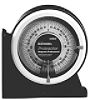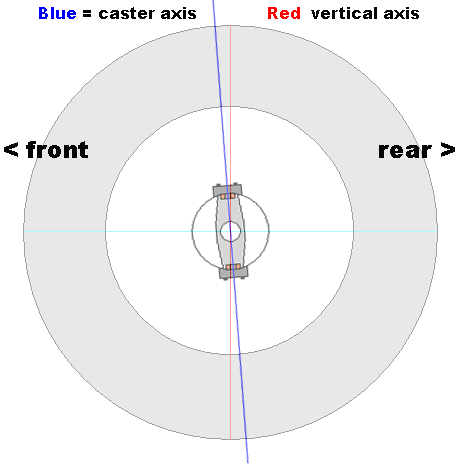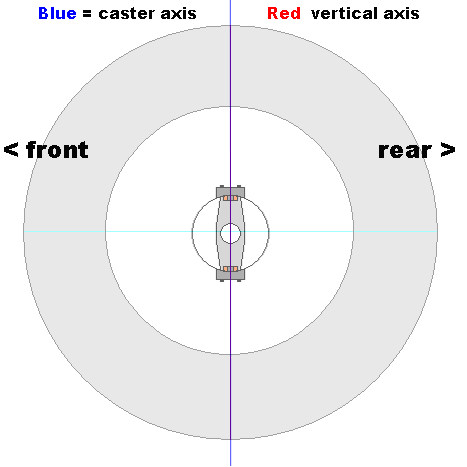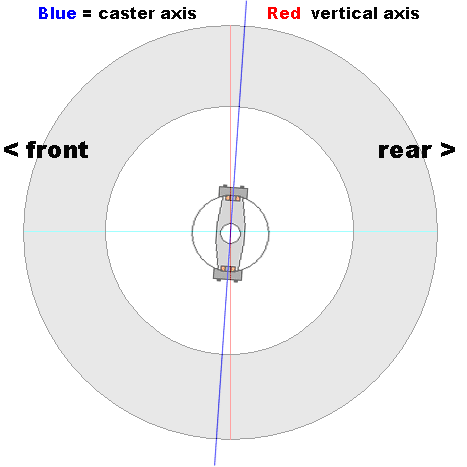
by Jim "Ack" Cambron
In the automotive world, Caster is defined as the angle of the rotational axis kingpin bearings on the steering system of a vehicle. The angle is usually expressed as a relationship between a line drawn at a right angle to the ground that the vehicle rest on and a line that passes through the center of the axis of rotation of a front wheel on a vehicle.
Cutting to the chase, here are three pictures that describe the above:

The first graphic shows Negative Caster.
Negative caster - in a more radical form - is used in shopping carts.

The second graphics shows Neutral caster.
Neutral Caster provides very little tracking stability.

The third graphic shows Positive caster.
Positive Caster is found in automotive steering designs and tends to straighten or center the wheel when travelling forward which adds to the straight-line stability of the vehicle. Positive caster is typically found in automotive steering systems and is usually in the range of 3 to 5 degrees
Here is the connection to the deadly "Death Wobble" Effect: Have you ever used a grocery store shopping cart that had one wheel that wobbled as you pushed the cart? I bet that cart was pretty annoying an a bit hard to control. If you looked closely at the shopping carts' wobbling caster you would notice that it had been banged really hard against something causing the wheel part to be bent backwards at an extreme angle. The same wobbling on that shopping cart's front wheel is what you are experiencing when the caster angle on your front axle is greater than 5 degrees - especially if you also have worn steering components.
What causes the caster angle to increase causing Death Wobble in your steering? Anything that radically changes the caster angle of the front axle can cause Death Wobble to set in.
Rotating the axle during a suspension lift in an effort to "improve" the pinion angle will drastically change the caster angle. Unfortunately, changing the pinion angle will only cause more drivetrain vibrations unless you use a driveshaft equipped with a double-cardan U-Joint. You can read more on this subject at Tom Wood's Driveline 101 Webpage
Installing very long spring shackles will dramatically change the caster angle by lowering the front of the spring relative to the rear of the spring effectively rotating the axle and increasing the caster angle. Long spring shackles can also cause the entire axle to wobble from side-to-side because the shackles flex or the bushings distort under the tremendous leverage that the extended shackles go through while you are driving.
how do you check your caster angle? The simplest method is as follows:
Park your truck on a level piece of ground like a garage floor.

Buy or borrow a magnetic protractor level and place it on top of the kingpin bolts at the top of the steering knuckle with the wheels pointing straight forwards.
The level should display the caster angle.
As mentioned earlier, there are other more subtle contributors to the dreaded Death Wobble besides a bad caster angle. These include worn steering joint seal felts, worn kingpin bearings, worn wheel bearings, worn tierod joints, a worn steering stablizer or a combination of any of these worn parts. An out-of-balance or damaged tire is also a possible cause. If you slowly develop a case of the Death Wobble, check the above-mentioned parts for wear. If your Death Wobble suddenly appears after a Spring Over Suspension (SPOA) lift, check your caster angle!
For more information on automotive Caster, check out these websites:
Camber, Caster and Toe: What Do They Mean? by John Hagarman
http://www.artsautomotive.com/thealignmentstory.htm
http://www.wisc-online.com/objects/index_tj.asp?objID=AMT1003